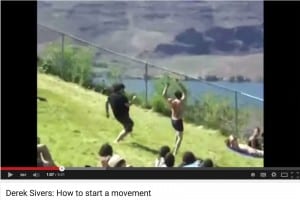At Meadows School of the Arts, we encourage our students to “Start a Movement.” This is not just an inspirational slogan, but also a meaningful challenge. This post explores How to Start a Movement.
Students are taught how to start a movement in the Arts Management and Arts Entrepreneurship class titled Entrepreneurship and the Hero Adventure (AMAE 3370). In this class, students learn how to serve as the “heroes of their own lives,” a thought made popular by the renowned mythologist Joseph Campbell, who developed the concept of the Monomyth. But what does this mean, to serve as a hero? Heroism is all about service. It typically involves sacrificing one’s own personal interest (or potential for one’s own gain) in the service of something larger than just oneself. This service might be towards a person, customer, audience, a people, community, an idea, a meaning or a combination of such things.
Heroes typically lead, and it is necessary for one to lead if they are to start a movement. Anyone can become a leader. What is required is a will to do so. According to famed marketing expert and author Seth Godin in his book Tribes, “A tribe is a group of people connected to one another, connected to a leader, and connected to an idea.” “Heretics are the new leaders. The ones who challenge the status quo, who get out in front of their tribes, who create movements.” He goes on to say, “A movement is thrilling. It’s the work of many people, all connected, all seeking something better.” He also states that “Part of leadership (a big part of it, actually), is the ability to stick with the dream for a long time. Long enough that the critics realize that you’re going to get there one way or another…so they follow.”
When creating a movement, it’s best to appeal to those who already agree with your message. Don’t try to convert the naysayers. “Growth doesn’t come from persuading the most loyal members of other tribes to join you. They will be the last to come around,” Godin says. Don’t try to convert those who subscribe to another tribe. They will also come last. Appeal to those who want to be a part of what you are offering and doing, people who already get it. Start, as Godin says, “with the passionate individuals who haven’t been embraced by other tribes yet.” Then lead them.
Entrepreneur Derek Sivers has a wonderful TED video about “How to Start a Movement.” In this video, he describes an individual who is doing his own thing, “the shirtless dancing guy.” This person may be viewed as a lone nut, as he is acting outside of the status quo. “A leader needs the guts to stand out and be ridiculed,” Sivers says. What makes them a leader is their first follower, a person the leader needs to embrace as an equal. “The first follower is what transforms a lone nut into a leader.” What they (together) are doing is not about the leader, but about something larger (the group), just as in the case of the hero. As a result of this being larger than just oneself, others may begin to follow. Sivers goes on to say, “So a movement must be public. It’s important to show not just the leader, but the followers because you find that new followers emulate the followers, not the leader.” He goes on to recap, “Remember the importance of nurturing your first few followers as equals so it’s clearly about the movement, not you.” “Leadership is over-glorified.” “So as we’re told that we should all be leaders, that would be really ineffective. If you really care about starting a movement, have the courage to follow and show others how to follow and when you find a lone nut doing something great, have the guts to be the first one to stand up and join in.”
A movement is about the collective. Whether you are leading or serving as a first follower, treat other followers as equals and people are more likely to want to be a part of what you are creating and doing. Make it about the movement and not just you and your interests. Make it about something larger than yourself alone. Serve heroically.
Tribes, and the leaders they follow have the potential to create movements.
In Tribes, Godin communicates some of the following advice:
- “There’s an explosion of new tools available to help lead the tribes we’re forming.”
- “All of it is worthless if you don’t decide to lead.” & “You can’t have a tribe without a leader–and you can’t be a leader without a tribe.”
- “Tribes are about faith–about belief in an idea and in a community. And they are grounded in respect and admiration for the leader of the tribe and for the other members as well.”
- “Organizations that destroy the status quo win.”
- “Whatever the status quo is, changing it gives you the opportunity to be remarkable.”
- “If you want to grow, you need to find customers who are willing to join you or believe in you or donate to you or support you. And guess what? The only customers willing to do that are looking for something new.”
- “People yearn for change, they relish being part of a movement, and they talk about things that are remarkable, not boring.”
- “Great leaders create movements by empowering the tribe to communicate. They establish the foundation for people to make connections, as opposed to commanding people to follow them.” “The first thing a leader can focus on is the act of tightening the tribe.”
- “People are most easily led when they want to go along.”
- A movement does not have to be large and “Great leaders don’t water down their message in order to make the tribe a bit bigger.” Godin goes on to say, “They realize a motivated, connected tribe in the midst of a movement is far more powerful than a larger group could ever be.” He goes on, “Some tribes thrive, precisely because they are small.”
Here is a video of Seth Godin talking about “Why You Need a Tribe.”
Summary:
To create a movement:
- Anyone can lead. Gather followers and treat them like equals.
- Show them how to follow.
- You can amass a tribe through myriad social networking tools.
- Movements are reactions to the status quo.
- Serve something larger than yourself, choose to live heroically.
- People yearn for change and talk about exciting things, not boring things.
- A tribe does not have to be large.
- Lead people who want to be led and who already get your message.
- Stick with the dream to outlast the critics.
Start a Movement today.
This post was written by Jim Hart, Director of Arts Entrepreneurship Program at SMU Meadows School of the Arts.





